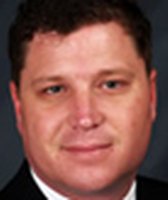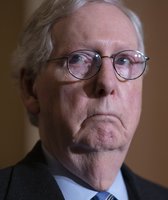Stand up for the facts!
Our only agenda is to publish the truth so you can be an informed participant in democracy.
We need your help.
I would like to contribute

Mayor Bill Foster and challenger Rick Kriseman faced off in the Tampa Bay Times/Bay News 9 mayoral debate on Oct. 15, 2013. Photo by Chris Zuppa | Tampa Bay Times.
Bill Foster says St. Petersburg's unemployment rate is lower than state average
Candidates for St. Petersburg mayor painted two very different portraits of the city’s economy during the recent Tampa Bay Times/Bay News 9 mayoral debate.
Mayor Bill Foster touted the city’s unemployment rate.
"We've added 5,000 new residents to the city of St. Petersburg," Foster said. "Unemployment in the city of St. Petersburg is below the state average."
Challenger Rick Kriseman’s response included claims about how there are fewer small businesses and fewer overall workers than before Foster took office in 2010.
We decided to put each candidate’s economic talk on the Truth-O-Meter. (We checked Kriseman's statements here and here.) In this fact-check, we’re looking at Foster’s claim about the unemployment rate.
Sign up for PolitiFact texts
Comparing the city’s unemployment rate with the state average is tricky.
The Bureau of Labor Statistics puts out monthly reports with unemployment data for the country, state and metro areas. Using this data to compare cities with their home states is a little bit like analyzing apples and oranges. Why? The national and state data is adjusted for the season, but the metro data is not.
The distinction between adjusted data and unadjusted data is important in Florida, where the economy is hugely susceptible to seasonal swings, economists told us. Think of the snowbirds who come to our state during the cooler months each year. They seek out services, pack restaurants, buy goods and visit the beach -- an annual economic stimulus.
"That doesn’t just affect tourism jobs," said Scott Brown, chief economist at Raymond James. "That affects everything."
That factor and others, such as teachers taking off for the summer, contribute to the state’s unadjusted employment rate typically ticking up in the summer months. When seasonal forces are factored in, the unemployment rate is smoothed out.
Cities do not get the same treatment, left only with the less precise, unadjusted figure.
With that disclaimer, we’ll move ahead with the check using labor data mostly from BLS.
2013 unemployment rate Month St. Pete (NSA) FL (NSA) FL (SA) Jan. 7.7 8 7.9 Feb. 7.1 7.6 7.8 March 6.6 7 7.5 April 6.8 6.8 7.2 May 6.9 7 7.1 June 7.4 7.4 7.1 July 7.4 7.4 7.1 Aug. 6.9* 7.1 7* From state Department of Economic Opportunity. NSA = Not seasonally adjusted, SA = Seasonally adjusted
So the state’s seasonally adjusted unemployment rate for August, the most recent month available, was 7 percent and the unadjusted rate is 7.1 percent.
The BLS did not release unemployment data for metro areas and cities as scheduled on Oct. 2 due to the government shutdown. The bureau’s most recent, public estimate for St. Petersburg’s unemployment rate is for July 2013, when the (unadjusted) rate was 7.4 percent. That’s even with Florida’s unadjusted rate for July and larger than its adjusted rate.
We checked in with the state’s Department of Economic Opportunity, which feeds some economic data to the BLS, before calling Foster’s claim inaccurate. According to DEO, the city’s unemployment rate for August was 6.9 percent -- a smidgen lower than the state’s unadjusted and adjusted rates for that month.
Featured Fact-check
The city’s unemployment rate was actually lower than the state’s, by either measure, for most of 2013.
We asked our experts to point to better data, but they said this home survey-based data is the best we have. Residents are asked if they are working and, if not, whether they are looking for work. The government uses the data to crank out assessments for the national, state and local levels.
"At the state level, they’re estimates," said Sean Snaith, a University of Central Florida economist. "So when you get down to the smaller and smaller geographies, the availability and timeliness of data both begin to wane."
A declining unemployment rate is not necessarily a completely positive measure of the economy, PolitiFact Florida has found. Florida has a problem with discouraged workers being out of the workforce for a long time and eventually dropping out of the labor force. These workers are no longer reflected in the unemployment rate, which is a ratio of the number of workers versus the number of available workers.
For example, Florida’s unemployment rate fell steeply from December 2011 to July 2013, from 9.4 percent to 7.1 percent. If the labor force had remained the same in July as it was a year and a half earlier, the real unemployment rate would have been 8.2 percent, according to an August 2013 report by the Legislature’s Office of Economic and Demographic Research. The report found that about half of the reason for the drop is due to people leaving the labor force or putting off joining it.
A similar analysis has not been completed at the city level.
Foster did not return our call seeking comment.
Our ruling
St. Petersburg’s unemployment rate is a little bit better than the state average, according to the most recent data we have from the state and federal government. It’s been the case for most of the year. Is it substantially better? No. And experts cautioned that the numbers we have are not the best. Still, they’re the best we have. We rate this statement Mostly True.
Our Sources
Series data for St. Petersburg from the Bureau of Labor Statistics (Google doc)
Interview with Scott Brown, Raymond James chief economist, Oct. 16, 2013
Interview with Sean Snaith, University of Central Florida professor and director of the Institute Economic Competitiveness, Oct. 16, 2013
Interview with Stanley Smith, director of population studies at the University of Florida’s Bureau of Economic and Business Research, Oct. 16, 2013
Interview with Jessica Sims, Florida Department of Economic Opportunity spokeswoman, Oct. 16, 2013
Interview with Timothy Ewing, Bureau of Labor Statistics researcher, Oct. 17, 2013
Browse the Truth-O-Meter
More by Katie Sanders
Bill Foster says St. Petersburg's unemployment rate is lower than state average
Support independent fact-checking.
Become a member!
In a world of wild talk and fake news, help us stand up for the facts.


















































